Lagerstroemia
Lagerstroemia /ˌleɪɡərˈstriːmiə/,[1] commonly known as crape myrtle[2][3] (also spelled crepe myrtle or crêpe myrtle, and often referred to in technical literature as crapemyrtle[4]), is a genus of around 50 species of deciduous and evergreen trees and shrubs native to the Indian subcontinent, southeast Asia, northern Australia, and parts of Oceania, cultivated in warmer climates around the world. It is a member of the family Lythraceae, which are also known as the loosestrife family. The genus is named after the Swedish merchant Magnus von Lagerström, a director of the Swedish East India Company who supplied Carl Linnaeus with plants he collected. These flowering trees are beautifully colored and are often planted both privately and commercially as ornamentals.
| Crape myrtle | |
|---|---|
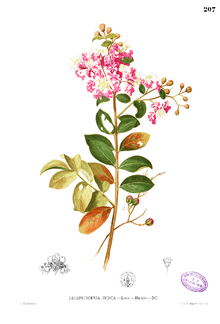 | |
| Lagerstroemia indica | |
| Scientific classification | |
| Kingdom: | Plantae |
| Clade: | Tracheophytes |
| Clade: | Angiosperms |
| Clade: | Eudicots |
| Clade: | Rosids |
| Order: | Myrtales |
| Family: | Lythraceae |
| Subfamily: | Lythroideae |
| Genus: | Lagerstroemia Linnaeus |
| Species | |
|
See text | |
Description
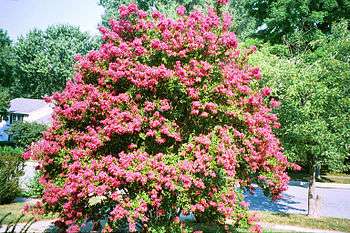

Crape myrtles are chiefly known for their colorful and long-lasting flowers which occur in summer. Most species of Lagerstroemia have sinewy, fluted stems and branches with a mottled appearance that arises from having bark that sheds throughout the year. The leaves are opposite and simple, with entire margins, and vary from 5–20 cm (2–8 in). While all species are woody in nature, they can range in height from over 30 m (100 ft) to under 30 cm (1 ft); most, however, are small to medium multiple-trunked trees and shrubs. The leaves of temperate species provide autumn color.
Flowers are borne in summer and autumn in panicles of crinkled flowers with a crêpe-like texture. Colors vary from deep purple to red to white, with almost every shade in between. Although no blue-flowered varieties exist, the flowers trend toward the blue end of the spectrum with no orange or yellow except in stamens and pistils. The fruit is a capsule, green and succulent at first, then ripening to dark brown or black dryness. It splits along six or seven lines, producing teeth much like those of the calyx, and releases numerous, small, winged seeds.
In their respective climates, both subtropical and tropical species are common in domestic and commercial landscapes. The timber of some species has been used to manufacture bridges, furniture, and railway sleepers,[5] but in Vietnam's Cát Tiên National Park, the dominant stands of Lagerstroemia calyculata in secondary forest are thought to have survived (after episodes of logging) due to the low quality of wood.[6] Lagerstroemia species are used as food plants by the larvae of some Lepidoptera (moth and butterfly) species including Endoclita malabaricus.
The leaves of L. parviflora are fed on by the Antheraea paphia moth which produces the tassar silk, a form of wild silk of commercial importance in India.[7]
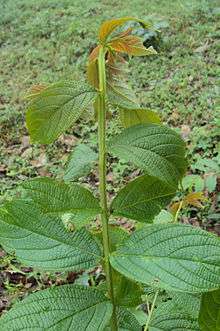
Landscaping and gardening
Certain species of crape myrtle are used in landscaping and gardening as screens, lawn specimens, shrub borders, and container plants. Since crape myrtles are found in many places, there are differing opinions as to how to cultivate them in landscaping. Crape myrtles are best cultivated in warmer southern climates, zones 7–9, and prefer full sun. They come in a variety of flowering colors and size.
Each year, the crape myrtles are often cut back ostensibly to allow for new growth over the next season, often referred to as crape murder. However, this notion that only new growth bears flowers is false though new growth does produce more flowers than established growth. Crape myrtles can at times be pruned in order to help shape the tree and get rid of unwanted or unsightly growth.
Cutting crape myrtles back too far can be detrimental because it prevents the trees from forming mottled bark on mature trunks that some people find beautiful. It also creates multiple skinny, whip-like shoot sprouts from the end of the stump that remains from the previous season. These whip-like shoots can become too weak to hold up the flowers, often causing the branches bend to the ground.
Crape myrtles are relatively suitable for foundations and walkways because the roots are not strong nor damaging to fixed structures. They form large networks of fine, fibrous roots rather than large, heavy penetrating surface or tap roots. The root zones however, can compete for water and nutrients with other plants that grow under the tree's canopy.
Crape myrtles have been considered messy, and their seedpods can stain concrete and are best planted away from swimming pools, decks and sidewalks.
 Crape myrtle during summer in Sombrerete, Mexico
Crape myrtle during summer in Sombrerete, Mexico Same tree during fall
Same tree during fall
Selected species
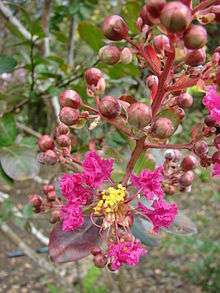
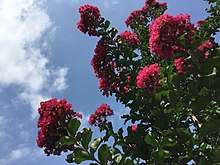
- Lagerstroemia anhuiensis
- Lagerstroemia anisontera
- Lagerstroemia anisoptera
- Lagerstroemia balansae
- Lagerstroemia calyculata
- Lagerstroemia caudata
- Lagerstroemia cristata
- Lagerstroemia excelsa
- Lagerstroemia fauriei
- Lagerstroemia floribunda
- Lagerstroemia fordii
- Lagerstroemia glabra
- Lagerstroemia guilinensis
- Lagerstroemia indica
- Lagerstroemia intermedia
- Lagerstroemia langkawiensis
- Lagerstroemia limii
- Lagerstroemia loudonii
- Lagerstroemia micrantha
- Lagerstroemia microcarpa
- Lagerstroemia minuticarpa
- Lagerstroemia "Natchez"
- Lagerstroemia ovalifolia
- Lagerstroemia paniculata
- Lagerstroemia parviflora
- Lagerstroemia siamica
- Lagerstroemia speciosa
- Lagerstroemia stenopetala
- Lagerstroemia subcostata
- Lagerstroemia subsessilifolia
- Lagerstroemia suprareticulata
- Lagerstroemia tomentosa
- Lagerstroemia turbinata Koehne
- Lagerstroemia venusta
- Lagerstroemia villosa
The common crape myrtle (L. indica) from China and Korea was introduced circa 1790 to Charleston, South Carolina, in the United States by the French botanist André Michaux. In the wild, the species is most often found as a multistemmed large shrub, but 200 years of cultivation have resulted in a huge number of cultivars of widely varying characteristics. Today, crape myrtle varieties can fulfill many landscaping needs, from tidy street trees to dense barrier hedges to fast-growing dwarf types of less than 60 cm (2 ft), which can go from seed to bloom in a season (allowing gardeners in places where the plant is not winter-hardy to still enjoy the intense colors of the frilly flowers). In Europe, crape myrtle is common in the south of France, the Iberian Peninsula, and most of Italy; in the United States, it is an iconic plant of gardens across the southern United States.[8]
While not as widely known, the Japanese crape myrtle, L. fauriei, from central and southern Japan, is becoming increasingly important, both as a landscaping plant and as a parent in complex hybrids with L. indica. This species is distinctly tree-like, with colorful deciduous bark and dark green leaves which are more resistant to fungal diseases than are those of its more popular relative. The Japanese name for this tree is saru suberi (猿滑、百日紅, literally "monkey slip", latter spelling ateji) which refers to the smooth, slippery bark. Flowers are as large as those of L. indica, but are white with only the slightest pink flush appearing in some individuals. Japanese crape myrtle is hardier to cold than many strains of L. indica, a characteristic (along with fungal resistance, tree form and colorful bark) that makes it valuable as genetic material for hybridization. Cultivars available include 'Kiowa', 'Fantasy', and 'Townhouse'.[9]
Lagerstroemia speciosa, known as queen crape myrtle, giant crape myrtle, or banabá, originates in subtropical and tropical India. It can be grown in any similar climate, but in the United States is suitable only for Florida, southernmost Texas, South Louisiana, coastal southern California, and Hawaii. It is a large evergreen tree with colorful rosy-mauve flowers and striking white bark, suitable for public parks and avenues; only the seed-grown species is commonly available for sale, unlike L. indica and L. fauriei, which have dozens of cultivars.
References
Notes
- Sunset Western Garden Book, 1995:606–607
- Merriam-Webster's Collegiate Dictionary (11th ed.)
- Garner's Modern English Usage, 4th ed. 2016 Oxford University Press
- https://rootmaker.com/sites/default/files/pdf/PlantNamesE.pdf
- Woodworkers Source: Pyinma.
- Blanc L, Maury-Lechon G, Pascal J-P (2000) Structure, floristic composition and natural regeneration in the forests of Cat Tien National Park, Vietnam: an analysis of the successional trends. Journal of Biogeography, 27: 141–157.
- "Non-wood forest products In 15 countries of Tropical Asia". fao.org. Archived from the original on 18 April 2014. Retrieved 30 January 2012.
- Gaspard Le Dem (2016-07-16). "It's Time To Appreciate D.C.'s Colorful Crape Myrtles". DCist. Archived from the original on 2019-08-11. Retrieved 2019-08-11.
- "Trees: Lagerstroemia fauriei". www.ces.ncsu.edu. Archived from the original on November 23, 2007. Retrieved 2008-01-07.
Further reading
- "Lagerstroemia". Australian Plant Name Index (APNI), IBIS database. Centre for Plant Biodiversity Research, Australian Government.
- Flora, The Gardeners' Bible, ABC Publishing, Ultimo, NSW, Australia, 2006
External links
| Wikimedia Commons has media related to Lagerstroemia. |
